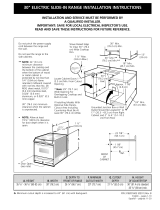
4
30" ELECTRIC SLIDE-IN RANGE INSTALLATION INSTRUCTIONS
Important Notes to the Installer
1. Read all instructions contained in these installation
instructions before installing range.
2. Remove all packing material from the oven
compartments before connecting the electrical supply
to the range.
3. Observe all governing codes and ordinances.
4. Be sure to leave these instructions with the consumer.
Important Note to the Consumer
Keep these instructions with your Owner's Guide for the
local electrical inspector's use and future reference.
IMPORTANT SAFETY
INSTRUCTIONS
Cold temperatures can damage the
electronic control. When using the appliance for the first
time, or when the appliance has not been used for an
extended period of time, be certain the unit has been
in temperatures above 32°F (0°C) for at least 3 hours
before turning on the power to the appliance.
• Be sure your range is installed and grounded
properly by a qualified installer or service
technician.
•This range must be electrically grounded in
accordance with local codes or, in their absence,
with the National Electrical Code ANSI/NFPA No.
70—latest edition in United States or with CSA
Standard C22.1, Canadian Electrical Code, Part 1 in
Canada.
•Theinstallationofappliancesdesignedfor
manufactured (mobile) home installation must conform
with Manufactured Home Construction and Safety
Standard, title 24CFR, part 3280 [Formerly the Federal
Standard for Mobile Home Construction and Safety,
title 24, HUD (part 280)] or when such standard
is not applicable, the Standard for Manufactured
Home Installation 1982 (Manufactured Home Sites,
Communities and Setups), ANSI Z225.1/NFPA 501A-
latest edition, or with local codes in United States and
with CAN/CSA-Z240 MH in Canada.
•Make sure the wall coverings around the range
can withstand the heat generated by the range.
•Before installing the range in an area covered
with linoleum or any other synthetic floor
covering, make sure the floor covering can
withstand heat at least 90°F (32.2°C) above room
temperature without shrinking, warping or
discoloring. Do not install the range over carpeting
unless you place an insulating pad or sheet of ¼"
(0.64 cm) thick plywood between the range and
carpeting.
Never leave children alone or
unattended in the area where an appliance is in
use. As children grow, teach them the proper, safe use
of all appliances. Never leave the oven door open when
the range is unattended.
Stepping, leaning or sitting on the
door or drawer of this range can result in serious
injuries and can also cause damage to the range.
•Do not store items of interest to children in
the cabinets above the range. Children could be
seriously burned climbing on the range to reach items.
•To eliminate the risk of burns or fire by reaching
over heated surface units, cabinet storage
space above the surface unit should be avoided.
If cabinet storage is to be provided the risk can
be reduce by installing a range hood that project
horizontally a minimum of 5 inches beyond the bottom
of the cabinet.
•Do not use the oven as a storage space. This
creates a potentially hazardous situation.
•Never use your range for warming or heating the
room. Prolonged use of the range without adequate
ventilation can be dangerous.
•Do not store or use gasoline or other flammable
vapors and liquids near this or any other
appliance. Explosions or fires could result.
•Reset all controls to the "off" position after using
a programmable timing operation.
FOR MODELS WITH SELF-CLEAN FEATURE:
•Remove oven racks, broiler pan, food and other
utensils before self-cleaning the oven. Wipe up
excess spillage. Follow the precleaning instructions in
the Owner's Guide.
To reduce the risk of tipping
of the range, the range
must be secured by properly
installed anti-tip bracket(s)
provided with the range.
To check if the bracket(s), is
installed properly, grasp the
top rear edge of the range
and carefully tilt it forward
to make sure the range is
anchored.
• Allranges
can tip.
• Injuryto
persons
could result.
• Installanti-
tip device
packed with
range.
Serial Plate Location
You will find the model and
serial number printed on the
serial plate. The serial plate is
located as shown.
Remember to record the
serial number for future
reference.













